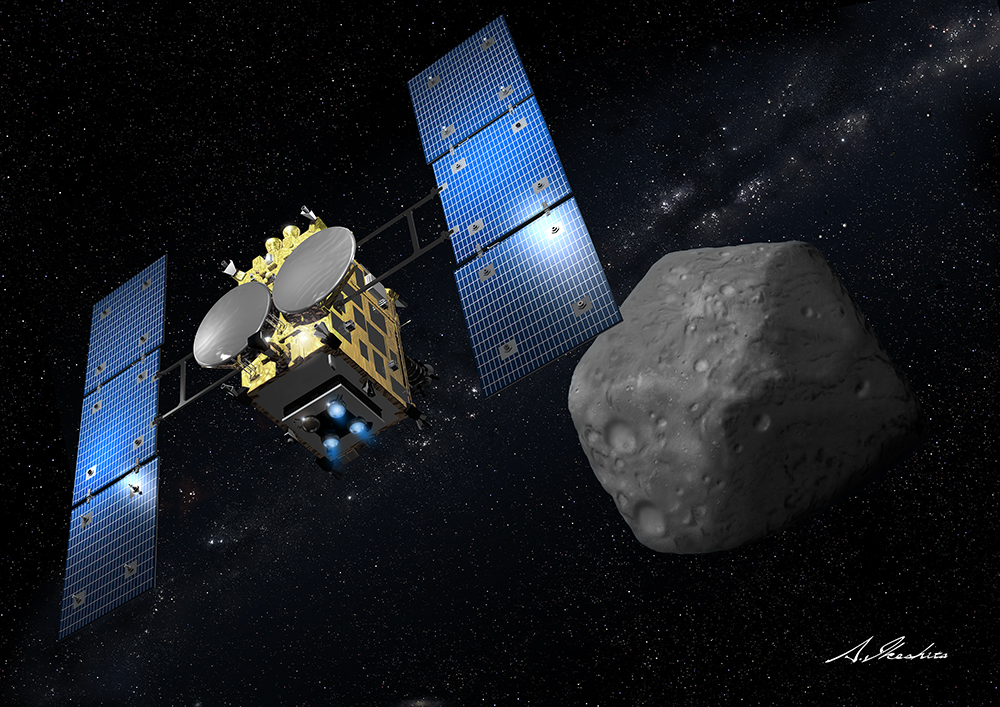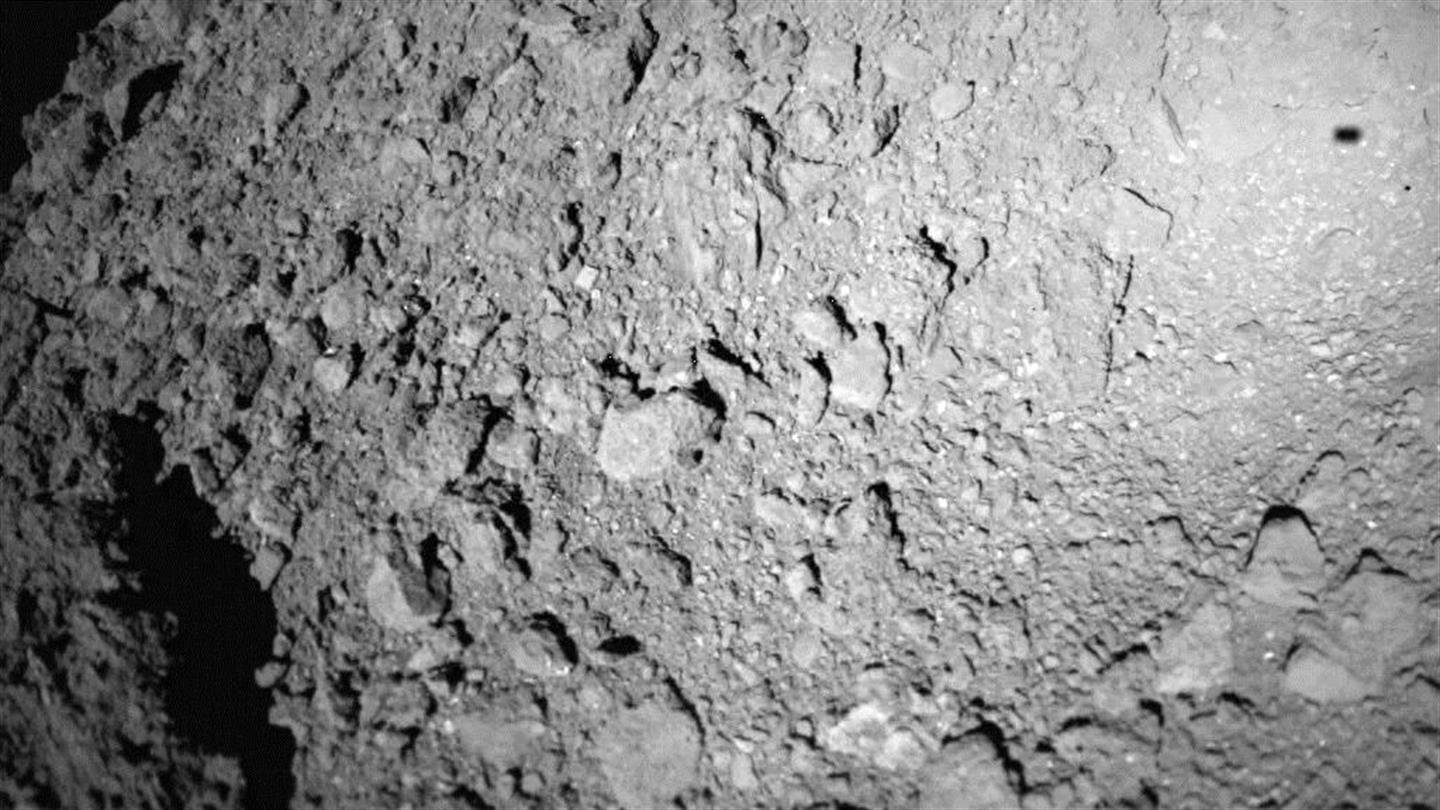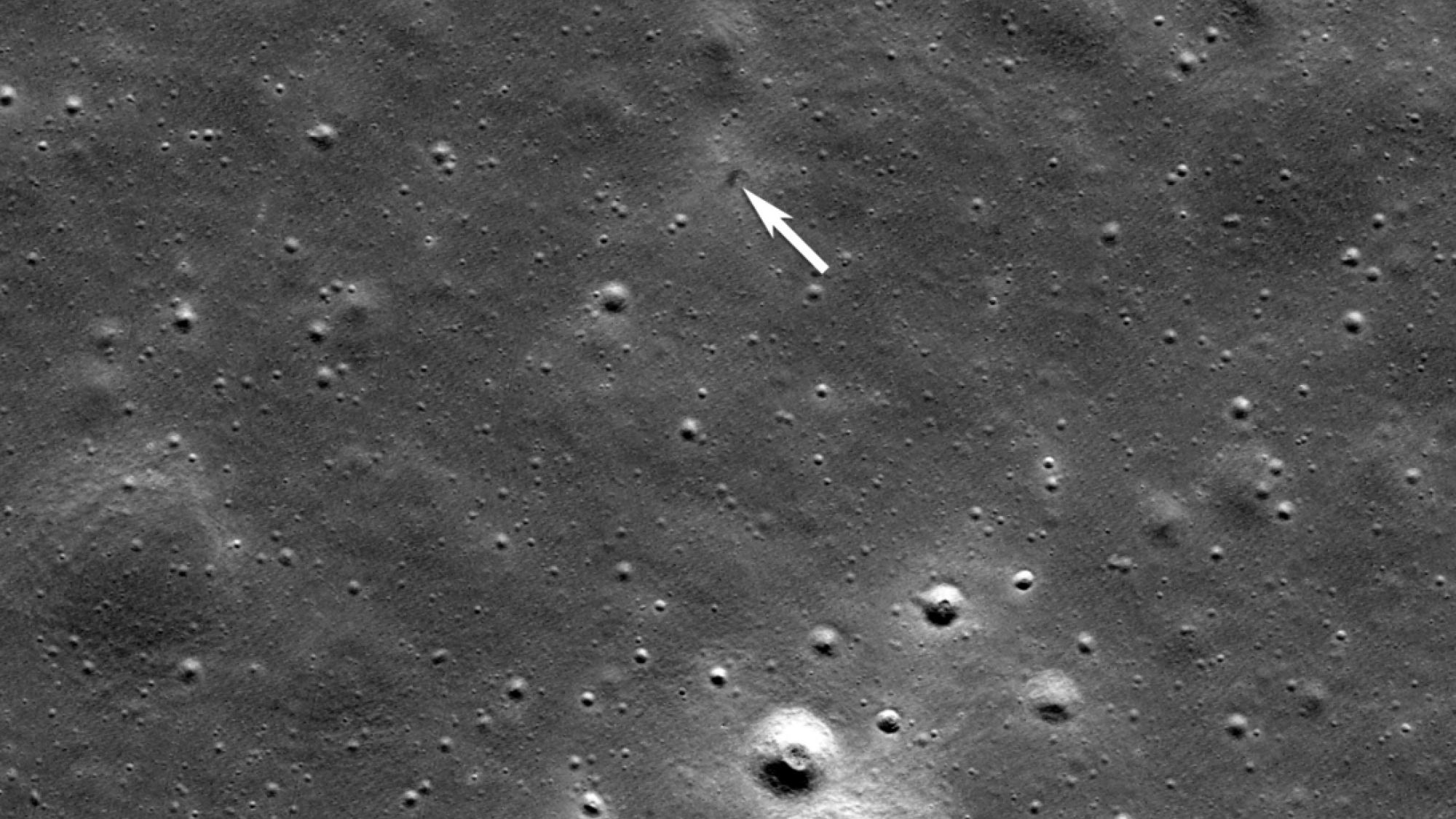Hayabusa2: Japan's 2nd Asteroid Sample Mission

Editor's Note: Hayabusa2's sample-return capsule is scheduled to land on Earth Dec. 6, 2020. Read more here.
Hayabusa2 is a Japanese asteroid-sampling spacecraft that launched in December 2014. It successfully rendezvoused with asteroid Ryugu on June 27, 2018, according to the Japanese Aerospace Exploration Agency (JAXA).
For 18 months, the probe will poke, prod and impact the asteroid, deploying a small lander and three rovers. It will then blast an artificial crater to analyze material below the asteroid's surface. After that, the probe will head back to Earth, arriving near the end of 2020 with samples in tow. [Related: Asteroid Arrival! Japanese Probe Reaches 'Spinning Top' Space Rock Ryugu]
The mission is a follow-up of Hayabusa, which returned samples of asteroid Itokawa to Earth in 2010 despite numerous technical difficulties.
Mission development
Hayabusa2 was first selected by Japan's Space Activities Commission in 2006,\ and received funding in August 2010 (shortly after Hayabusa's return). The cost is estimated at 16.4 billion yen ($150 million).
The basic configuration of Hayabusa2 is very similar to Hayabusa, except for some improved technology, according to JAXA. Here are some of the improvements on Hayabusa2.
- Ion engine: Improving the lifespan of the neutralizers (which failed on Hayabusa) by strengthening the internal magnetic field. Also, more careful checks of the ion engine will be performed to improve its propulsion generation and ignition stability.
- Sampler mechanism: Better seal performance, more compartments and an improved mechanism for picking up material from the surface. On Hayabusa, it was unclear at the time of sample collection if it had actually picked up something from the surface.
- Re-entry capsule: JAXA has added an instrument to measure acceleration, movement and interior temperatures during flight. (The Hayabusa capsule broke up during re-entry.)
- Flat antennas: Instead of Hayabusa's parabolic antenna, Hayabusa2 has flat antennas. This allows it to have the same communication capacity as Hayabusa, while saving on weight (and launch fuel). "A flat antenna can perform to the same capacity as a parabolic antenna due to technological improvements ... Thanks to the flat design, the weight of the antenna is reduced to one-fourth, compared to a parabolic antenna whose performance is the same." JAXA said.
Here are the major instruments of the mission:
- Small Carry-on Impactor (SCI): This will create an artificial crater on the surface of the asteroid. Hayabusa2 will look at the changes on the surface before and after the impact takes place. They will also sample the crater to get "fresh" materials from underground.
- Near InfraRed Spectrometer (NIRS3) and Thermal Infrared Imager (TIR): The spectrometer will look at mineral composition of the asteroid, and the properties of water there. The imager will study the temperature and thermal inertia (resistance to changing temperature) of the asteroid.
- The small rovers MINERVA-II: Three small rovers will bounce along the surface and collect data from close-up. They are successors to the MINERVA rover aboard Hayabusa, which failed to meet its target after launch.
- A small lander (MASCOT): This is a lander that will jump only once after it arrives on the surface. It will also perform close-up observations of the surface. This instrument is built by DLR (Germany's space agency) and the CNES (France's space agency).

Touchdown!
On September 21, 2018, Hayubasa2 ejected the first two rovers, MINERVA-II1A and MINERVA-II1B. The rovers were deployed when the satellite was about 180 feet (55 meters) above the surface of the asteroid, mission team members said. Each of the disk-shaped robots measure 7 inches wide by 2.8 inches tall (18 by 7 centimeters), with a mass of about 2.4 lbs (1.1 kilogram). Instead of rolling along like Martian rovers, the pair hopped from place to place on Ryugu.
"Gravity on the surface of Ryugu is very weak, so a rover propelled by normal wheels or crawlers would float upwards as soon as it started to move," Hayabusa2 team members wrote in a MINERVA-II1 description. "Therefore, this hopping mechanism was adopted for moving across the surface of such small celestial bodies. The rover is expected to remain in the air for up to 15 minutes after a single hop before landing, and to move up to 15 m [50 feet] horizontally." [Hop, Don’t Roll: How the Tiny Japanese Rovers on Asteroid Ryugu Move]
Shortly after they were deployed, the Hayubasa2 team members on Earth established a communication link with the rovers. That link was briefly lost due to the asteroid’s rotation.
Once the link was re-established, the two rovers sent home photos and videos from the surface of the asteroid. Photos were captured not only from the surface but also from the air by the leaping robots.
"Please take a moment to enjoy 'standing' on this new world," JAXA officials said in a statement. The video was shot over the course of 1 hour and 14 minutes beginning on Sept. 22 at 9:34 p.m. EDT (0134 GMT on Sept. 23). [Japan's Hayabusa2 Asteroid Ryugu Sample-Return Mission in Pictures]
The MASCOT rover deployed successfully at 9:57 p.m. EDT Oct. 2 (0157 GMT on Oct. 3) and came to a rest on Ryugu shortly after.
"It could not have gone better," MASCOT project manager Tra-Mi Ho, from the DLR Institute of Space Systems in Bremen, Germany, said in a statement. (DLR is the German acronym for the German Aerospace Center, which built MASCOT in collaboration with the French space agency, CNES.)
Like MINERVA-II1A and -II1B, MASCOT moves by hopping. A metallic ‘swing arm’ inside of the rover can be manipulated to provoke motion or to right itself on the asteroid’s surface.
The shoebox-size robot was in operation for more than 17 hours — a bit longer than the mission’s expected 16 hours. All of the data it collected on the asteroid was successfully transmitted to Hayubasa2.

Science goals
Japan chose a different type of asteroid to study for Hayabusa2. The goal is to collect information about a wide variety of asteroids across the solar system. Ryugu is a C-type asteroid, meaning that it is carbonaceous; with a high percentage of carbon, this is the most common type of asteroid in the solar system. (The target for Hayabusa was Itokawa, an S-type asteroid — meaning that it is made up more of stony materials and nickel iron.)
Ryugu is an older type of body than Itokawa, and likely contains more organic or hydrated minerals, JAXA stated. Organics and water are key elements for life on Earth, although their presence on other bodies doesn't necessarily mean life itself.
"We expect to clarify the origin of life by analyzing samples acquired from a primordial celestial body such as a C-type asteroid to study organic matter and water in the solar system, and how they co-exist while affecting each other," JAXA said.
This article was updated on Oct. 23, 2018 by Space.com Contributor, Nola Taylor Redd.
Join our Space Forums to keep talking space on the latest missions, night sky and more! And if you have a news tip, correction or comment, let us know at: community@space.com.
Breaking space news, the latest updates on rocket launches, skywatching events and more!

Elizabeth Howell (she/her), Ph.D., was a staff writer in the spaceflight channel between 2022 and 2024 specializing in Canadian space news. She was contributing writer for Space.com for 10 years from 2012 to 2024. Elizabeth's reporting includes multiple exclusives with the White House, leading world coverage about a lost-and-found space tomato on the International Space Station, witnessing five human spaceflight launches on two continents, flying parabolic, working inside a spacesuit, and participating in a simulated Mars mission. Her latest book, "Why Am I Taller?" (ECW Press, 2022) is co-written with astronaut Dave Williams.
